
The Gyeongbu line (Gyeongbuseon) is a railway line in South Korea and is considered to be the most important and one of the oldest in the country. It was constructed in 1905, connecting Seoul with Busan via Suwon, Daejeon, and Daegu. It is by far the most heavily travelled rail line in South Korea.
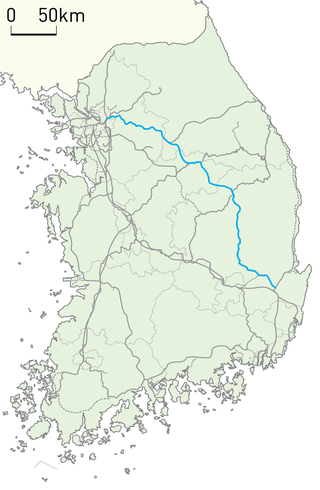
The Jungang line is a railway line connecting Cheongnyangni in Seoul to Moryang in Gyeongju in South Korea, traversing central South Korea from the northwest to the southeast. It is also referred to as the rail line of the Seoul Metropolitan Subway from Yongsan station to Jipyeong station. The section from Cheongnyangni to Dodam was designated as a semi-high-speed railway.
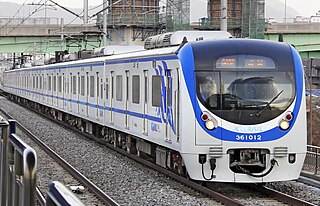
The Gyeongchun Line is a regional rail line between Seoul and Chuncheon, South Korea, operated by Korail. Its name is derived from Gyeong and Chuncheon. It was completely reconstructed in the 2000s. Service on it has operated between Sangbong station on the Jungang Line in eastern Seoul and Chuncheon station, as part of the Seoul Metropolitan Subway system, since December 21, 2010. A class of regional rail service named ITX-Cheongchun began operations on February 28, 2012, linking Chuncheon to Cheongnyangni and Yongsan Stations.

Korea Train eXpress (Korean: 한국고속철도), often known as KTX, is South Korea's high-speed rail system, operated by Korail. Construction began on the high-speed line from Seoul to Busan in 1992. KTX services were launched on April 1, 2004.

Hyundai Rotem Co. is a South Korean company that manufactures rolling stock, defense products and plant equipment. It is a part of the Hyundai Motor Group. Its name was changed from Rotem to Hyundai Rotem in December 2007 to reflect the parent company. It is also called Hyundai Railroad Technology Systems.
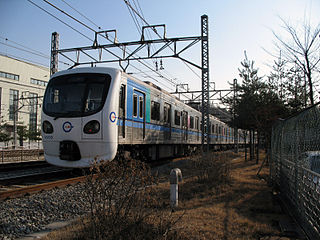
The Incheon Subway is a subway system serving the South Korean city of Incheon. The system is operated by Incheon Transit Corporation, and is part of the greater Seoul Metropolitan Subway.

Daegu Metro is a metro system that serves primarily the South Korean city of Daegu, operated by Daegu Transportation Corporation from 5:30AM to 0:00AM with the interval from 5 to 8 minutes between each car's arrival. With the fastest track speed at 80 km/h (50 mph), it takes 55 minutes for Line 1 and Line 2, and 48 minutes for Line 3 to reach the terminus station. As of 2015, the number of average daily passengers is 186,992 people for Line 1, 177,984 people for Line 2, and 69,127 people for Line 3.

Seoul Subway Line 9, operated by Seoul Line9 Operation, is a subway line in Seoul, part of the Seoul Metropolitan Subway. The line runs east from Gaehwa station or Gimpo International Airport station along the south bank of the Han River towards VHS Medical Center in Gangdong. In 2019, Line 9 had an annual ridership of 225 million or about 616,000 people per day.

AREX is a South Korean airport rail link and commuter rail line that links Incheon International Airport with Seoul Station via Gimpo International Airport.

The Gyeongbu high-speed railway, also known as Gyeongbu HSR, is South Korea's first high-speed rail line from Seoul to Busan. KTX high-speed trains operate three sections of the line: on 1 April 2004, the first between a junction near Geumcheon-gu Office station, Seoul and a junction at Daejeonjochajang station north of Daejeon, and a second between a junction at Okcheon station, southeast of Daejeon, and a junction near Jicheon station, north of Daegu entered service; then on 1 November 2010, the third section, between a junction west of Daegu and Busan became operational. The missing gaps across the urban areas of Daejeon and Daegu were in construction for an expected opening in 2014, separate tracks into Seoul Station were also planned. The temporary ends of the three sections were connected to the parallel conventional Gyeongbu Line by tracks that will serve as interconnector branches upon the completion of the entire line. On 1 August 2015, construction on urban areas of Daejeon and Daegu were completed; all the sections of HSR line were connected.
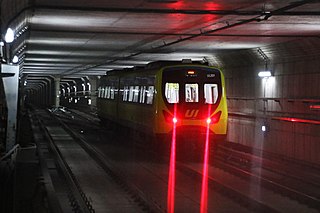
The Ui LRT, referred to as the Ui-Sinseol LRT or Ui-Sinseol Line (우이신설선) in Korean, is a light metro which is part of Seoul Metropolitan Subway. It is a fully underground 11.4 km (7.1 mi) Light Rapid Transit line from Ui-dong to Sinseol-dong in northern Seoul which opened on September 2, 2017. The line, which is expected to carry 110,000 passengers a day, has 13 stations. It connects to Line 4 at Sungshin Women's University, Line 6 at Bomun and Lines 1 & 2 at Sinseol-dong. The last (northernmost) station is in Ui-dong, hence the name of the line. In 2019, the line carried 27 million passengers or about 75,000 people per day.

The KTX-Sancheon is a South Korean high-speed train built by Hyundai Rotem in the second half of the 2000s and operated by Korail since March 2010. With a top speed of 305 km/h (189.5 mph), the KTX-Sancheon is the second commercial high-speed train operated in South Korea and the first domestic high-speed train that is designed and developed in South Korea.

The KTX-I, also known as the TGV-K or Korail Class 100000, is a South Korean high speed train class based on the French TGV Réseau. The 20-car formation of the trainsets without a restaurant car is optimized for high capacity. The 46 trainsets were built partly in France and partly in South Korea in the framework of a technology transfer agreement, which was the basis for further domestic high-speed train development in South Korea.
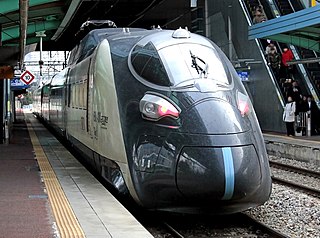
HEMU-430X is a South Korean high-speed train intended for a maximum speed of 430 km/h (267 mph). On 31 March 2013, it achieved 421.4 km/h (261.8 mph) in a test run, making South Korea the world's fourth country after France, Japan and China to develop a high-speed train running above 420 km/h (261 mph). The main new feature of the train compared to older South Korean high-speed trains is distributed traction. The commercial versions of the trains, tentatively named the EMU-260 and EMU-320, were delivered to Korail from 2020 to 2021.
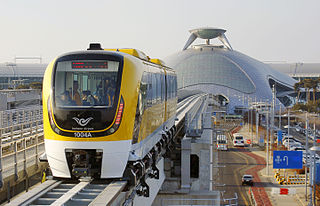
The Incheon Airport Maglev was a maglev line in South Korea that opened on 3 February 2016 and closed on 1 September 2023. It was the world's second commercially operating unmanned urban maglev line after Japan's Linimo. The trains were lighter, cutting construction costs in half. The majority of construction was completed by November 2012.

Pangyo Station (Korean: 판교역) is a station on the Shinbundang Line, serving the planned city of Pangyo in the city of Seongnam. The station is close to Pangyo Techno Valley, one of the country's largest clusters of software, gaming, entertainment and biotechnology businesses, home to major tech companies like Kakao. It began operations on October 28, 2011, with the opening of the Shinbundang Line.
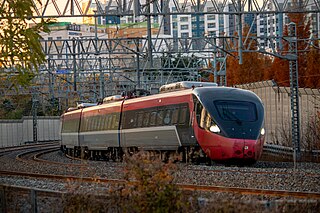
The Intercity Train eXpress-Saemaeul is a class of train operated by Korail, the national railroad of South Korea, it was introduced on May 12, 2014, to replace the Saemaeul-ho. The new ITX-Saemaeul trains have a faster average speed of 150 kilometers per hour. The name was taken from the Saemaul Undong after a public competition to determine the new train's name.
The Korean Train Control System (KTCS) is a train protection system established as a standard specification for the South Korean railway.

The National Science Museum Maglev was a maglev line in Daejeon, South Korea that opened on 21 April 2008 and closed on 31 December 2020. It was a 995 m (3,264 ft) long line that connected the National Science Museum to the Expo Science Park in Yuseong District. It was the first maglev train line to begin commercial operation in the country.

UTM-02 is a South Korean maglev train developed for the continuous research of magnetic levitation trains. The vehicle development was undertaken by the Korea Institute of Machinery and Materials. It was used on the National Science Museum Maglev line.


















